Summer Season 2021 Preview – Competing with Olympics 2020?
Summer Season 2021 is proving something of a mixed bag. There’s the return of some well-loved series for a second season such as Miss Kobayashi’s Dragon Maid, Beastars and My Second Life as a Villainess…but do any of the new titles stand out? (And indeed, why have a few of them been so late to start, Crunchyroll’s Fena: Pirate Princess, for example, now due in mid-August?) Is this somewhat lacklustre collection down to the fact that they’re airing (or sometimes not) alongside the 2020 Olympics – and the companies have played safe with a few stand-out favourites, filling up the rest of the schedules with B movie equivalents? (Although those can be fun!) The Anime UK News writers have chosen their top picks of the new bunch – but have they missed anything good? Let us know…
Darkstorm
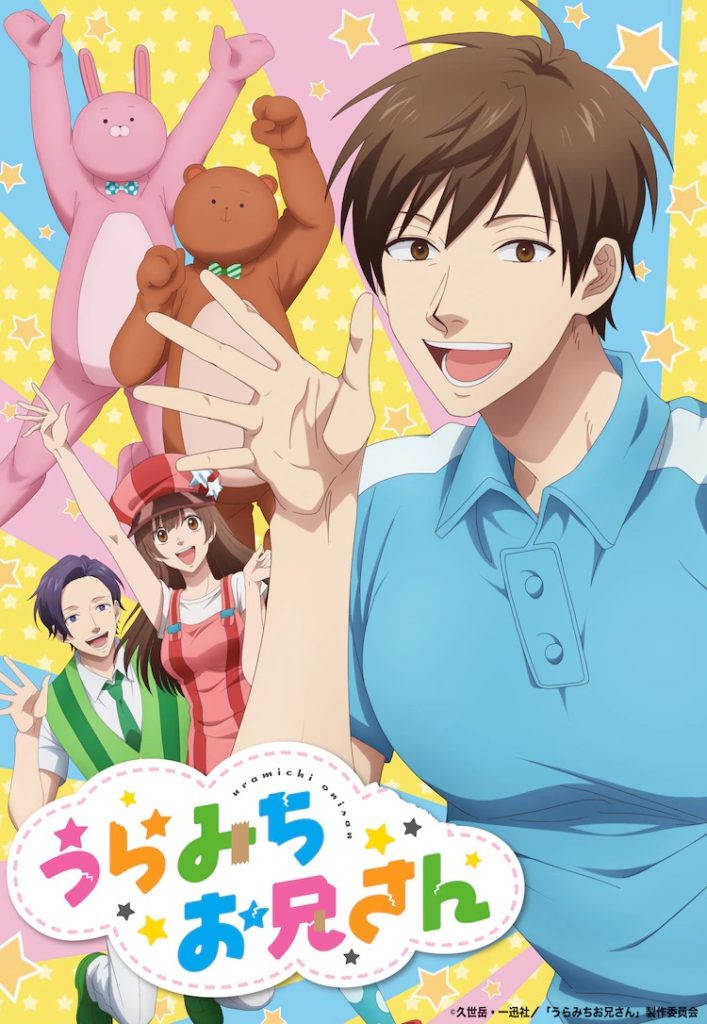
I reviewed the first two manga volumes of Life Lessons with Uramichi Oniisan back in April, and I wrapped up my positive review to say that I was looking forward to the anime adaptation, especially since the story itself has a lot of songs and I wanted to see if they sounded as funny as the lyrics made them out to be (songs are hard to make work in any text-based media, regardless of genre). Now the anime is here, after production issues apparently delaying it from 2020 to now, I’m so far enjoying it, despite a few adaptation choices that I don’t think particularly work.
The anime is very faithful to the manga, with the first two episodes adapting eight chapters. That’s a lot of material and the series plays it out like lots of mini-webisodes stitched together into half-hour episode (not unlike how The Way of the House Husband did it). There are a few chapters that do follow on from each other, which work well, but some of them are self-contained which I think messes up the pacing of the anime. It’s more forgiving in a manga as originally it was a digital-only series, and shorter bursts of stories spaced out are expected, but for an anime, unless you’re releasing mini-episodes sporadically, it runs the risk of affecting the comedy a touch because there’s no room for the end gags to land correctly before the show moves onto the next one. Also I did dislike how the first episode just had a voiceover and huge blocks of text introducing the characters; in the manga there were text boxes but, again, that works for the medium, yet in the anime it comes across as lazy. But let’s forget the negatives and think of the positives; if you enjoyed the manga, then you’ll enjoy the anime too. The whiplash between the up-beat children’s presenter façade and the grim reality of adulting is adapted marvellously here; the show makes great use of its soundtrack, with sharp, almost gritty sound effects for the tone changes, and the score often going just-off key when the moment calls for it really helps the comedy land. There’s also a few jokes in the manga that I didn’t find amusing but ended up working better in the anime, mostly thanks to Mamoru Miyano who voices Iketeru, the good-looking male presenter who loves dirty jokes; his laughter at the dick-word play sounded so genuine that I couldn’t help but laugh myself. Also, I don’t normally use this word, but the ending theme ‘Dream On’ also by Mamoru Miyano, is a banger!
Whilst comedy is so hard to recommend to people, because they’re so subjective, I do think it’s worth giving this a go if the premise caught your attention at all. Luckily the first two episodes are free to watch (with or without subscription) on Funimation.
Onosume
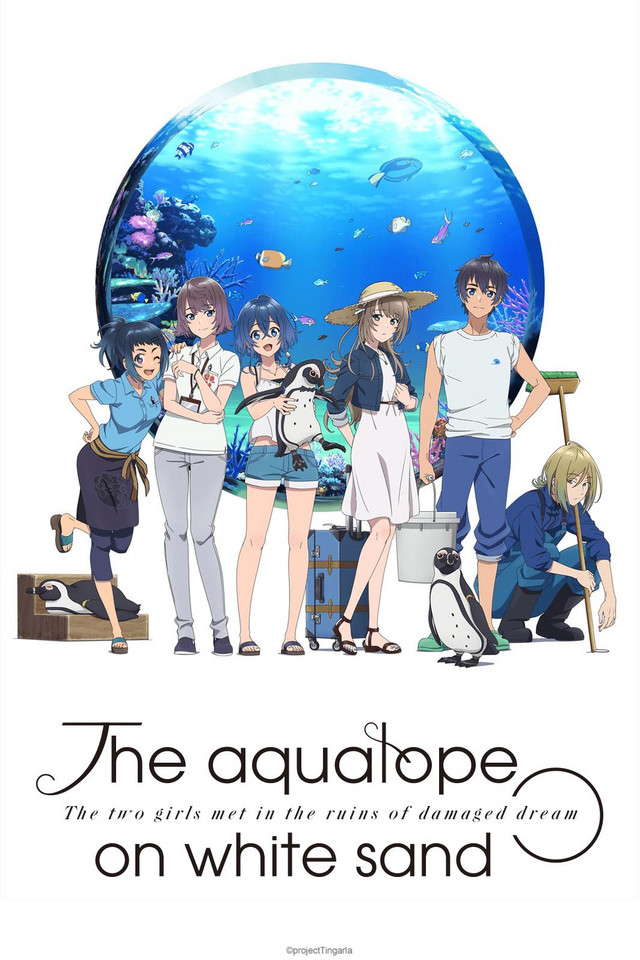
With the vast majority of shows this season falling into the isekai bucket, The Aquatope on White Sand is proving to be a real breath of fresh air. A delicate coming-of-age drama, Aquatope focuses on two teenage girls, Fuuka, who has been forced out of her job as an idol in Tokyo and finds herself running away to Okinawa, and Kukuru, who is spending her summer break working at her grandfather’s small aquarium on the island, trying to find a way to prevent it from shutting down.
The main things drawing me into this series are not only its characters but also its beautiful animation and choice of setting. Being a subtropical island known mainly for its beaches, Okinawa gives P.A. Works plenty of material to work with in painting a very idyllic getaway that must seem like a dreamland for someone like Fuuka, coming from Tokyo’s concrete jungle. While it might be easy to get lost in that beauty, P.A. Works is careful not to lose themselves in it, as once we get past the initial delights of sunset beaches, we see two girls facing various hardships and struggling to find their way in life, with Fuuka not sure what to do after having her dreams of becoming a top idol dashed, while Kukuru is struggling to keep open the aquarium that has been a cornerstone in her life, despite her grandfather’s more realistic decision of shutting down and transferring the animals elsewhere, as you can’t look after them if you haven’t got the money.
There’s also the touch of the supernatural, with writer Yuuko Kakihara following up nicely on her previous work with P.A. Works, Iroduku: The World in Colors, as we frequently see an imp that can somehow give people mysterious visions where they are plunged into the depths of the sea. Who this imp is and how it ties into the rest of the story remains to be seen, but it gives the show a nice touch at critical points in the story.
While a lot of P.A. Works’ shows can be very hit and miss depending on the writers and other production staff the studio works with, The Aquatope on White Sand is so far showing itself to be one of the stronger entries in the studio’s portfolio. It looks great, has an interesting cast of characters that can be developed over the course of the series, and an interesting story with a touch of the supernatural. My only concern at this point is that it may not be able to carry itself over its stated 24-episode runtime, as with the direction the story is going in, it seems like it could wrap itself up in a single season quite nicely.

Moving from has-been idols to would-be idols, this season sees the long-awaited next chapter in the Love Live! franchise, Love Live! Superstar!!.
Set in Tokyo’s youthful and fashionable districts of Harajuku, Omotesando and Aoyama, Superstar!! tells the story of Kanon Shibuya, a girl who loves to sing but has struggled with terrible stage fright since she was a small child, never being able to perform on stage when it matters most. As such, after applying to the prestigious Yuigaoka Private Girls High School, she ends up failing the performance part of the entrance exam, placing her in the school’s general programme instead of its music programme. While she initially accepts that this is probably for the best, things begin to change when she meets Keke Chang, an excitable girl with Chinese and Japanese parentage who wants to form a school idol club. After hearing Kanon sing, Keke decides to recruit her as a club member and won’t take no for an answer! While she is eventually able to get Kanon on board with her idea, the two are met with disdain from the music programme students and are shut down by the student council president, who claims school idols would reflect badly on the school’s reputation as a musical powerhouse. Appealing to the school’s director, the girls are given one chance to prove their worth and win a competition in order for their club to see the light of day.
Just two episodes in and Love Live! Superstar!! already feels on-brand for a Love Live! series. You’ve got familiar character archetypes, from the idol nerd and the talented musician to the disapproving student council president, the same dramatic and over-the-top comedic beats, and some solid musical numbers, while eagle-eyed long-time fans will spot the return of the feather motif in a very sweet passing of the baton moment. In tone though, this feels closer to Nijigasaki rather than the original series or Sunshine!!, being very light-hearted with no schools about to be closed down. As such, I think this is more aiming to be goofy idol fun rather than anything else, and at this point I’d be perfectly okay with that, as long as we get to see our main characters creep out of their shells and grow into the superstars they are meant to be. It’ll be interesting to see how the group dynamics change with the reduction to five girls here over the more standard nine, however I am hoping it will make it feel a little more grounded after Nijigasaki, which in my opinion suffered early on from introducing too many characters at once.
Love Live! as a franchise now has an established formula, and there’s certainly nothing wrong with sticking to it as it definitely works and changing things up too much can be a large risk, as some other idol shows have proved. So, ultimately this is probably going to be more of the same, and if you are an existing fan of the franchise like I am, then I’m sure we’re all going to have a lot of fun with it, and even if you’re not, this is a great time to jump on board.

My final pick for this season is Kageki Shoujo!!, Pine Jam’s adaptation of Kumiko Saiki’s manga about a group of teenage girls who enrol at Kouka School of Musical and Theatrical Arts, all hoping to become the next stars of the stage.
This series, which follows the events of what is now known as The Curtain Rises or Kageki Shoujo!! Season Zero, is a bit of an odd one as it has a very light and fluffy exterior, but an incredibly dark interior. While there is a feeling of animosity and intense competition from all of the characters in the opening episode, with all of them wanting to claim the spotlight in leading roles, the main lead is so utterly charming that it does give you a false sense of security. Sarasa Watanabe is a very enthusiastic bundle of joy who stands out anyway due to her height, but does so even more with her off-the-wall happy-go-lucky attitude. She has a dream of playing Lady Oscar from The Rose of Versailles, even though she is said to be too tall for the role, but she doesn’t let that stop her from going for it, nor the silly rumours that anyone who stands underneath the cherry blossom tree at the front of the school will never land a main role, as she does on her first day.
Sarasa ends up becoming roommates with the other main lead, former idol Ai Narata, who, unlike Sarasa, comes off as a very serious yet unimpressionable person who has become jaded with the entertainment industry. After suffering a series of abuses from men, Ai has come to musical theatre to escape to a world where women are the main audience. However, running away doesn’t do her much good when a stalker fan from her time as an idol follows her to the school and reawakens some unspeakable trauma.
For those of a sensitive disposition, this may be a series to approach with caution as it goes on to show highly disturbing scenes of child abuse that should have warranted content warnings on the episodes themselves. Rest assured though, as it does a good job of handling such a sensitive topic that can still say “no, this is wrong” while shocking you as viewer.
While this was certainly a surprising twist, it’s still a very enjoyable show to watch, with some highly entertaining moments even if they are mostly provided by Sarasa. As such, I’m hoping we get to see a lot more of the supporting cast as the show continues, and I’m hoping it can balance out its lighter and darker elements to produce a good character-based story. If you’ve enjoyed other theatre-inspired shows in the past such as Revue Starlight or have an interest in musical theatre in general then I think you’ll probably enjoy this one, provided you can get through some of its darker content.
The Aquatope on White Sand and Love Live! Superstar!! are both streaming on Crunchyroll, while Kageki Shoujo!! is streaming on Funimation.
Sarah
Is it just me? But I’m really struggling to find any enthusiasm for most of the new series this season. A couple of titles have caught my attention– but so much of the rest just doesn’t appeal. I’ve tried. I’ve never quit so many series so early – and sometimes after only half an episode.
However, The Case Study of Vanitas has – rightly – grabbed viewers’ attention from the get-go with its utterly gorgeous evocation of an alternate 19thc steampunk Paris (the City of Flowers) and its new take on the vampire mythos.
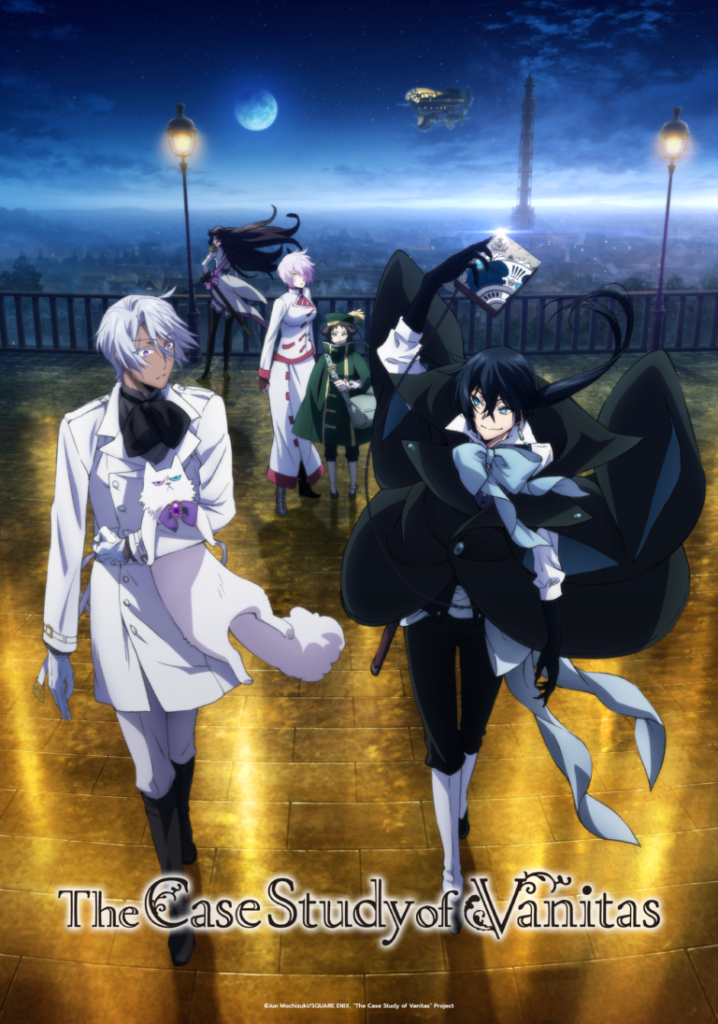
In an alternate nineteenth century France, humans and vampires co-exist – well, as long as the vampires don’t go rogue and start attacking humans. On his way to Paris by airship, vampire Noé Archiviste encounters the charismatic Vanitas who makes a spectacular entry into the vessel when a young woman vampire loses control. Vanitas claims he can cure her by restoring her true name and uses a mysterious volume, the Book of Vanitas, calling on the power of the Blue Moon. This is also the very book that Noé has been sent to Paris to investigate by his mentor whom he calls ‘Teacher’. And so begins an unlikely kind of partnership, with Noé and Vanitas making a spectacular exit from the airship over Paris – only to be arrested and thrown into prison!
I’ve been reading Jun Mochizuki’s ongoing manga from the get-go in 2015. (Yen Press still publish it digitally in English as each new chapter appears in Japan) so I’ve had several years to think about the characters and their story. And, as with Jun Mochizuki’s earlier success Pandora Hearts, I’m conflicted. I love it – but I also find myself extremely annoyed and frustrated by certain aspects of storytelling favoured by this gifted mangaka. Fortunately, the tight script has – thus far – streamlined the story very effectively, managing to avoid some of the obscure hints and bewildering perorations that the mangaka favours which make reading the manga both a joy and a curse. Without spoiling anything (as far as possible) the final ominous, prophetic line of the very first episode (and the first manga chapter) is going to hang like a dark cloud over every interaction: This is the tale of how I met Vanitas…and of how we walked together …of all we gained and lost… and of how…at the end of that journey…I would kill him with my own two hands.

The anime has pulled out all the stops to bring this alternative France to life; it’s difficult not to feel as wonderstruck as Noé experiencing the wonders of Paris for the first time with stars in his eyes. And it’s such a pleasure to see the white-haired, good-hearted young vampire in all his many expressions, chibi and otherwise (and very convincingly voiced by Kaito Ishikawa, Iida in MHA) – paired with Murr, his cat and constant companion (I just love Murr!). I’m not so sure about Natsuki Hanae (Odokawa in ODDTAXI) Vanitas’s VA yet – there’s a lot of maniacal laughter that doesn’t ring true which might well be the way he’s been told to portray the character and might just be that he’s not quite up to the role.
The score is by Yuki Kajiura – I’m usually a big fan. However, what’s with this quoting/borrowing of the melody for The De’il amang the Tailors (on an accordion, I think)? This series is set in (alternate) nineteenth century Paris, not at a ceilidh in the highlands of Scotland.
It’s not a BL or a yuri story, in spite of what some other readers/viewers may have been suggesting. That said, it constantly teases the viewers with hints, maybes and might-have-beens while keeping its main characters, Vanitas and Noé, paired with female counterparts in Jeanne and Noé’s childhood friend Dominique de Sade (Domi) respectively, as well as being frenemies. (I’m not a fan of using the term queerbaiting, but this is yet another of those manga/anime which likes to keep all its options open, constantly toying with the audience’s expectations.) The story plays with deceits and betrayals, terrible deeds and atrocities in the past whose repercussions are still being felt by the descendants and survivors.
Best then to just sit back and enjoy this rich visual feast from Bones with all the masked balls, chandeliers, and Parisian sights and sounds brought to vivid life by animators and cast.
The Case Study of Vanitas is streaming on Funimation.
HWR
As another season gets underway I also found myself intrigued by the premise of Life Lessons with Uramichi Oniisan, a series revolving around a gymnastics coach, Omata Uramichi, who entertains children as part of an educational TV show.
Whilst at first glance this premise seems innocent enough, the series quickly establishes Uramichi’s relative lack of emotional stability as his dark thoughts and pessimistic world views creep into his professional interactions with the children on the show and also his work with the other cast members.
Whilst the initial episodes did play into some similar gags and set-ups, the series has began to give more insightful looks into Uramichi’s personal life and I’m curious to see how this will unfold, while continuing to showcase some dark humour and funny interactions.

Elsewhere I’ve also found some solid enjoyment so far in How a Realist Hero Rebuilt the Kingdom, which, while not breaking much in terms of new ground from a story perspective, has still delivered a solid fantasy outing four episodes in.
The familiar premise of someone, in this case protagonist Kazuya Souma, being whisked away to another world, sees him taking command of a kingdom using not weapons or strength but instead his wit and intelligence as he works to strategize and secure his newfound realm. Souma as a lead is likeable here and the series has been incorporating more of the central cast each week and showcasing how they might play into Souma’s plans.

Finally there’s the perhaps more sedate series in Drugstore in Another World – The Slow Life of a Cheat Pharmacist, a more laidback fantasy series about Reiji Kirio, another unassuming fellow who ends up in another world, and in this case ends up running a drugstore. It’s been a pleasant and inoffensive offering so far though some might find it more dull than endearing.
Life Lessons with Uramichi Oniisan and How a Realist Rebuilt the Kingdom are available to stream on Funimation and Drugstore in Another World – The Slow Life of a Cheat Pharmacist is available to stream on Crunchyroll.
Demelza
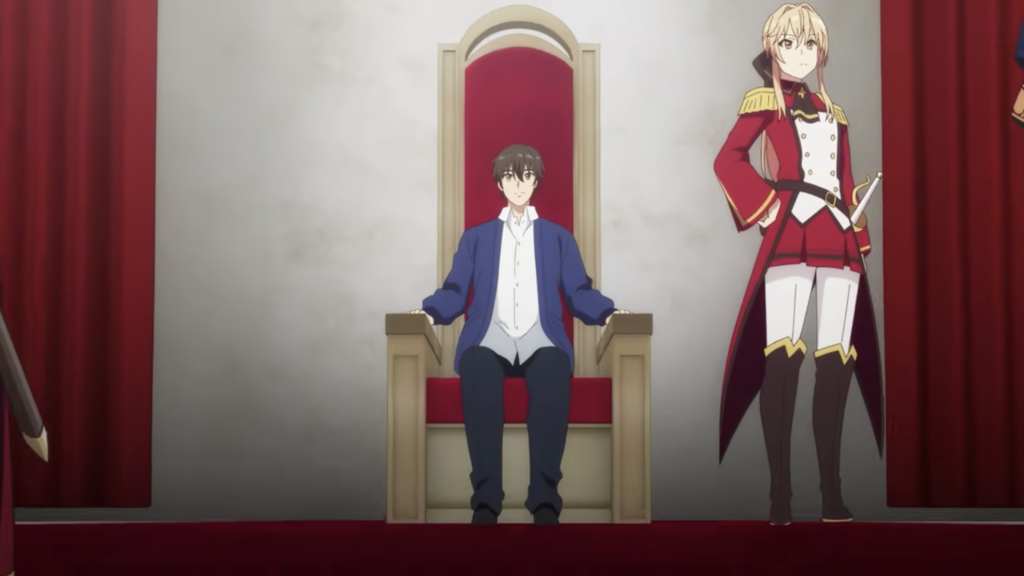
After an absolutely stacked Spring season, I’ve been looking forward to a bit of a break over the Summer. This season is traditionally a quieter one and I think that holds true this year, although there are quite a few of our favourite shows returning to our screens! While I’m certainly excited about the return of That Time I Got Reincarnated as a Slime, Miss Kobayashi’s Dragon Maid and My Next Life as a Villainess I can’t help but let my attention drift toward some of the newer series airing.
The show I’ve been most excited about this Summer is the anime adaptation of How a Realist Hero Rebuilt the Kingdom. The story follows Kazuya Souma who is summoned from his life in Japan into the kingdom of Elfrieden. After some discussions with the current king, it’s decided that Kazuya is far better suited to rule the land and the current king quickly hands over the throne!
Now Kazuya is left engaged to princess Liscia and needing to bolster his ranks if he’s got any chance of improving the quality of life in this place. It’s a huge challenge but with Kazuya’s intelligence and determination perhaps he can get through this crisis…
How a Realist Rebuilt the Kingdom is based on an ongoing light novel series, which is available in English through J-Novel Club and Seven Seas. While the show is an isekai, I’ve always fondly thought of it as a kingdom-building series, since instead of a focus on fighting monsters or becoming a hero, Kazuya improves the country through more mundane means. It’s fascinating to watch or read, but can be a bit slow if you’re expecting something more action-packed.
In fact, I was worried that the series wouldn’t transition all that well to anime but having now seen a few episodes, it’s clear that my worries were unfounded. Studio J.C Staff has brought some great talent to the project and despite how much of the show is spent with lengthy dialogue exchanges, they manage to keep it interesting – which is no easy feat. If you’re looking for a new political drama or you’re an existing fan of the books, then this adaptation certainly won’t disappoint.

Next up is another series I’ve been particularly excited about – The Detective is Already Dead. The story follows Kimihiko Kimitsuka, who four years ago was an assistant to the detective Siesta. In the present day, Siesta is dead and Kimihiko has returned to his normal everyday life, but one day a new encounter changes his life once more…
Although the series is only at four episodes, it feels like it has had five, thanks to a double-length opening instalment. However, despite the length of time we’ve already spent with the show, it seems as though it’s only getting into the meat of the story now. I would say it’s slow going, but some of this is because the anime team (studio ENGI), rearranged some of the content from the first light novel. In many ways, this arrangement makes more sense and allows us to get more attached to Siesta as her first case with Kimihiko makes up the opening episode, but in other ways, it has held the whole thing back. Now we’re over that initial hump I’m looking forward to seeing how it handles the rest of the story from here on out. There are plenty of interesting ideas here and the cast is more than likeable enough to hold the whole thing together, but I do worry that chopping and changing so much so early has lost some potential fans.
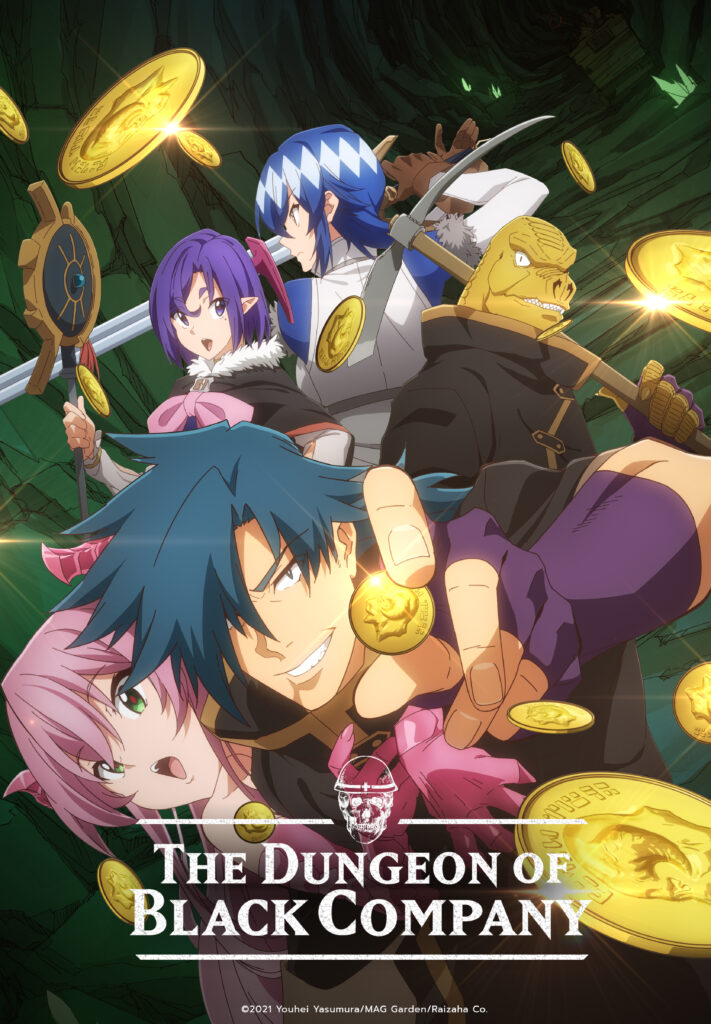
For my final pick, we’re back to the isekai genre with The Dungeon of the Black Company, an adaptation by Silver Link of an on-going manga series. This anime follows the adventures of Kinji, who has lived a life of luxury in Japan until he’s suddenly transported into another world. Here he finds himself working for a crooked corporation, but there’s only so much slaving Kinji is willing to do before he snaps and vows to build up a company all of his own in this world.
Like many Silver Link anime, this one is not to be taken seriously and instead is just pure fun. Kinji as a protagonist is intelligent and it’s easy to root for his success, but his get-rich schemes often come crashing down around him in hilarious ways. In many ways, it reminds me of KonoSuba except for the fact Kinji’s party is generally quite capable.
Ultimately if you’re sick of the isekai genre, this one won’t do a single thing to win you over, but if you’re looking for a new comedy with some capable animation then this one should be on your radar.
How a Realist Rebuilt the Kingdom, The Dungeon of the Black Company and The Detective is Already Dead are all streaming on Funimation.
Josh A. Stevens
Sometimes, we encounter a piece of fiction that resonates with us. Maybe it’s a character, a storyline, or even the setting – something grabs us because we feel a connection between it and our own lives – our own stories. Sayaka Miki from Puella Magi Madoka Magica remains close to my heart even now because the world punishing her for daring to do something for someone else really resonated with me at the time, and even coincidental connections like Schubert’s “Ave Maria” being the song her love Kyosuke regularly played – a widely known classic that I first encountered at a loved one’s funeral. However, sometimes a connection can seem a bit… uncanny.
With his career in a rut, a man in his late-20s goes back to university to follow his passion for the creative arts. There, he learns about screenwriting, filmmaking and more alongside a group of inspiring classmates who are almost guaranteed success in the future. Question: is this a description of Remake Our Life!, a brand-new anime series, or recent events in my own life? The answer is both! Which might be why this series has grabbed me in such a big way.
Kyoya Hashiba, 28, is left bankrupt after a brief job at the video game developer of his dreams ended in bankruptcy. Reflecting on where his life went wrong, he drifts off to sleep and wakes up at that pinnacle moment 10 years earlier: when he chose to attend a bog-standard university over one dedicated to the creative arts. Now choosing to follow his passion at the Osaka University of Arts, Kyoya finds himself living in a dorm with students destined to become the “Platinum Generation” that he admired so much in his former life. With this second chance at life, can Kyoya make a happier and more successful future for himself?
Remake Our Life! starts off strong with a double-length premiere that takes its time to show us where Kyoya’s ended up. It’s a harrowing yet also engaging fifty minutes as we’re invited into the mind of a man listlessly dragging his feet through a city where everyone else is busy, enthused by the prospect of his big break, and then numbed when it’s all taken away. This opening is bleaker than anything the series has shown since (at time of writing), but it really does help set up how… refreshing and hopeful Kyoya’s second chance is. From that point forward, Remake Our Life feels notably breezier as a fun slice-of-life about creative students, although there are already potential signs of drama to come.

While I haven’t cracked time travel (yet), there were enough similarities between myself and Kyoya that I admittedly briefly wondered if the series’ original author Nachi Kio was somehow writing about me. Alas, the series actually started two years before I myself decided to enrol in a creative arts course, roughly ten years after I dropped out of a more “conventional” degree. With Kyoya retaining the memories of his older life, I think that the series has done a wonderful job of capturing the mature student experience. For example, both Kyoya and myself have had moments where we realised our extra years offered little advantage when compared to the talent of our classmates!
Even though I’m still a student, I also can’t help but feel nostalgic when watching Remake Our Life!. Due to the ongoing pandemic, I had to spend almost all of my second year learning remotely, so seeing Kyoya and friends tasked with shooting a short film as their first group assignment (as it was for me – complete with camera rental issues!), made me yearn for that first-year feeling of discovery, and the feeling of being behind a camera again.
If I had to say that there’s a particular message in Remake Our Life, I’d guess that it’s about encouraging us to pursue what we really want, instead of what society expects of us. It’s when the series has focused on exploring this idea that it’s been at its strongest and most affecting so far, like when the normally sweet and peppy aspiring actress Nanako faces a crisis of confidence and has to question where her passion really lies after watching herself in a short film.
As an aspiring creator myself, I love anime about similar people and industries, like Shirobako and Comic Girls of yesteryear. Remake Our Life! has had a captivating start that could propel it to their ranks, especially if it continues to explore similar dramatic threads. However, I’m admittedly looking ahead with some trepidation. You see, Remake Our Life! has certainly had moments that… remind me that it’s an anime. For example, our introduction to future illustrator Aki Shino was Kyoya waking up to find her beside him with exposed cleavage, before she wakes up and the yoghurt she drinks drips onto her chest because… of course it does. Similarly, brief moments of fanservice are few and far between (and we’ve already crossed off the obligatory beach trip), but with the female cast already showing varying signs of affection towards Kyoya, I really hope that Remake Our Life! sticks to following their paths to fruitful careers, and not Kyoya’s potential harem.
Remake Our Life! is streaming on Crunchyroll.


